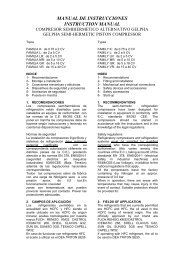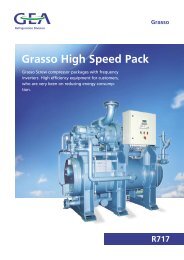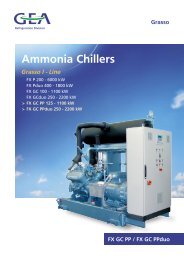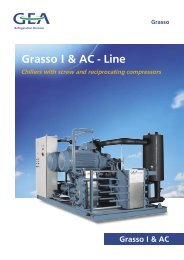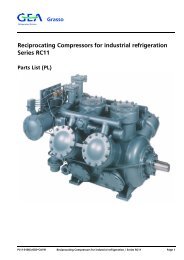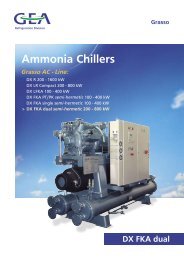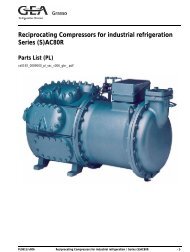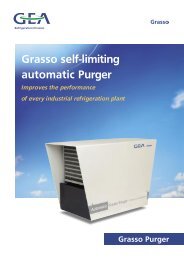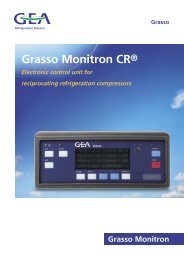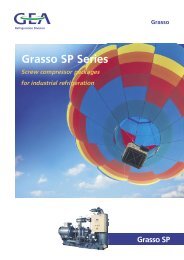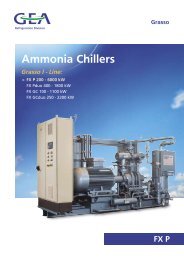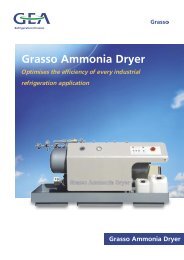RC(U)6 Installation and Maintenance Manual - Marine Refrigeration ...
RC(U)6 Installation and Maintenance Manual - Marine Refrigeration ...
RC(U)6 Installation and Maintenance Manual - Marine Refrigeration ...
Create successful ePaper yourself
Turn your PDF publications into a flip-book with our unique Google optimized e-Paper software.
<strong>Refrigeration</strong> Division<br />
Grasso<br />
B8 CLEANING OF SUCTION GAS FILTER(S)<br />
a) Evacuate the compressor (refer to §B5).<br />
b) Remove the four bolts holding the suction stop valve<br />
<strong>and</strong> remove the valve.<br />
c) Pull the strainer element out of the suction strainer<br />
housing without damaging the gauze. (see also fig.<br />
<strong>RC</strong>6-11 on parts list page 12).<br />
d) Clean element by rinsing it in a solvent. Then<br />
thoroughly dry the element preferably with<br />
compressed air.<br />
e) Check the gauze for damage.<br />
f) Slide the strainer element again into the housing <strong>and</strong> fit<br />
the suction stop valve. Check the oilit gasket for proper<br />
condition.<br />
c) Purge the compressor (refer to §B10).<br />
B9 DISMANTLING, INSPECTION AND RE-ASSEM-<br />
BLY OF SUCTION AND DISCHARGE VALVES<br />
The suction <strong>and</strong> discharge valves of a refrigeration<br />
compressor are parts that are heavily loaded both<br />
mechanically <strong>and</strong> thermally. Wear <strong>and</strong> life time of the<br />
valves strongly depend on the operating conditions<br />
of the compressor. A high working temperature <strong>and</strong><br />
rapid temperature variations shorten the life time of<br />
the valves, which, for this reason, require regular<br />
inspection.<br />
For dismounting, inspection <strong>and</strong> re-assembly of<br />
the valves, proceed as follows:<br />
a) Evacuate the compressor (refer to par. B5).<br />
b) Remove the cylinder head covers.<br />
c) Remove the pressure ring <strong>and</strong> buffer spring.<br />
d) Lift the complete discharge valve out of the cylinder<br />
liner.<br />
e) Remove the suction valve ring <strong>and</strong> sinusoidal springs,<br />
which are loose on the collar of the cylinder liner.<br />
f) Unscrew <strong>and</strong> disassemble the discharge valve.<br />
g) Clean all valve parts <strong>and</strong> check them for break of<br />
damage.<br />
MIND! If it appears that valve parts are broken, also<br />
the cylinder liner <strong>and</strong> piston of the relevant cylinder<br />
must be checked for damage.<br />
B: INSPECTION, MAINTENANCE<br />
AND TROUBLE SHOOTING<br />
The valve rings <strong>and</strong> valve seats must be undamaged;<br />
even the slightest damage may easily cause breakage.<br />
Valve ring <strong>and</strong>/or seat should be replaced when, due<br />
to wear, the total score of valve ring <strong>and</strong> seat is over<br />
0.2 mm.<br />
The sinusoidal springs must also be undamaged <strong>and</strong><br />
must have sufficient slack height.<br />
REMARK! All valve parts can be obtained<br />
separately, except the discharge valve<br />
seat, stroke limitor <strong>and</strong> central bolt. If,<br />
for example, the discharge valve seat is<br />
to be renewed, a complete discharge<br />
valve (including stroke limitor, valve<br />
ring <strong>and</strong> sinusoidal springs) should be ordered<br />
(also refer to the parts list).<br />
h) Carefully clean all valve parts <strong>and</strong> slightly oil them with<br />
compressor oil; then re-assemble the discharge valve.<br />
j) After reassembling the discharge valve, check<br />
whether the valve ring <strong>and</strong> springs can be pressed<br />
against the stroke limitor, <strong>and</strong> when released, the<br />
valve ring is properly pressed back on its seat.<br />
k) Place the suction valve ring <strong>and</strong> the corresponding<br />
sinusoidal springs on the collar of the cylinder liner<br />
<strong>and</strong> install the discharge valve, buffer spring <strong>and</strong><br />
pressure ring.<br />
l) Check the gasket of the cylinder head cover <strong>and</strong> lay<br />
the cover onto the cylinder head.<br />
m) Screw all hexagonal bolts <strong>and</strong> firmly tighten them.<br />
n) Purge the compressor (refer to par. B10).<br />
REMARK! In order to reduce the downtime<br />
involved in this valve inspection, it<br />
is recommended to have as many complete<br />
valve assemblies in stock as there<br />
are cylinders on the compressor.<br />
The valves can then be exchanged with<br />
the valves to be checked. The original<br />
valves can then be inspected at leisure<br />
<strong>and</strong>, if necessary, repaired or replaced.<br />
B1.6 <strong>Installation</strong> <strong>and</strong> <strong>Maintenance</strong> <strong>Manual</strong> <strong>RC</strong>(U)6 v001.99.01.en



